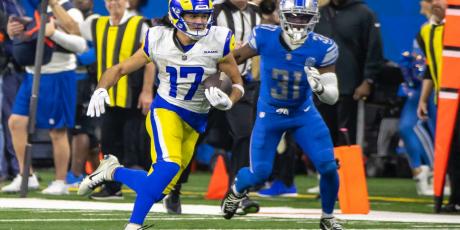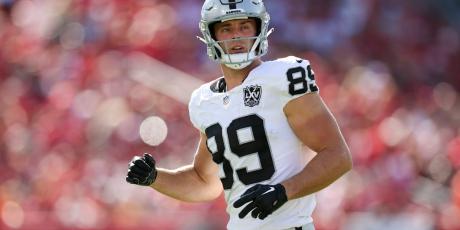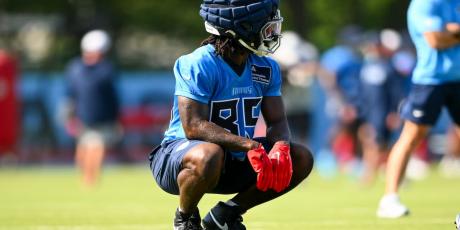Breaking Down Fantasy Football Running Back Draft Strategies

There are several strategies to attack the running back position in your fantasy football draft, with many different —sometimes confusing— nomenclatures. While going into your draft with a cut-and-dry strategy and ignoring what is going on around you is never a great idea, it is important to know when and why to begin implementing one should the opportunity arise.
Additional Running Back Content: RB Rankings | RB Handcuff Charts & Targets | RB Breakouts | Zero RB Targets and Implications in Fantasy Football
Below I will outline the four most popular running back strategies, go over both the positives and negatives of using each of them, and most importantly, point out the best times for utilization.
Robust Running Back
Explanation of Strategy
By beginning the draft with three straight running backs, and typically selecting a fourth in one of the two following rounds, fantasy players can look towards commanding a corner of the market with first and second-tier running backs to eliminate the need to scramble at the position later in drafts.
Positives
It typically works better in best-ball leagues where you are all but guaranteed to fill your two running back slots with week-to-week production regardless of bye weeks or injuries. Not having to attack the waiver wire for presumptive starters following a running back injury frees up free agent bidding to ensure better you can stream at the onesie positions weekly.
Negatives
You are now very short on wide receiver talent, which is the most difficult thing to replace on the waiver wire. Every year there is waiver wire gold at the running back position, but very rarely do we find a wide receiver who the consensus was believed to be un-roster able to end up producing league-winning upside. On top of that, you are going to be struggling weekly with who to start, in addition to taking up your flex spot, when there is overwhelming evidence that wide receivers deliver a higher ceiling at the beginning of drafts, particularly in half-and-full-PPR leagues.
Implementation/Examples
This isn’t my favorite strategy, but I understand the pressure to use it if you’ve been screwed by the running back position in years past, and hey, who hasn’t? If you are going to use the strategy, at least use it in the middle or back-half of the draft order, as starting with Christian McCaffrey or Jonathan Taylor just to keep hitting on the position will be sinking an enormous amount of draft capital into your bench. Below is an example of how the first 10 rounds of a typical half-PPR league might look out of the five-spot with this strategy, using 4for4’s Draft Hero tool.
| Player | Position | Team | Draft Slot |
|---|---|---|---|
| Derrick Henry | RB | Titans | 1.05 |
| Leonard Fournette | RB | Buccaneers | 2.08 |
| James Conner | RB | Cardinals | 3.05 |
| Terry McLaurin | WR | Commanders | 4.08 |
| Brandin Cooks | WR | Texans | 5.05 |
| Adam Thielen | WR | Vikings | 6.08 |
| Russell Wilson | QB | Broncos | 7.05 |
| Chase Edmonds | RB | Dolphins | 8.08 |
| Pat Freiermuth | TE | Steelers | 9.05 |
| Marquez Valdez-Scantling | WR | Chiefs | 10.08 |
Balanced RB
Explanation of Strategy
This approach is honestly not unlike “BPA”, or, best player available. It’s a pretty cut-and-dry undertaking, and really drives home the importance of using tiers while drafting. Once you have tiered rankings of every position laid out in front of you, you can target tiers that are close to drying up during the draft, and that will typically equal out to a balanced approach across all positions, including running back.
Positives
You will often come out of the draft with some strengths across all positions, not falling behind more than a couple of teams at each position. As you come across values as the draft goes along, they stick out like a sore thumb as you can get incremental legs-up on your competition.
Negatives
Your team is not exemplary at any one position, reducing your chances to “go nuclear” on an opponent in any given week. Sometimes this strategy delivers a stagnant team with too many players that end up being mediocre to above average; not good enough to lean on, and too much-perceived value to simply drop, leaving you in the cold while other teams cycle through players to find a league winner on the waiver wire.
Implementation/Examples
Considering this is mostly just value-based drafting, you can install it from any draft slot you would like. Below is an example of how the first 10 rounds of a typical half-PPR league might look out of the 11-spot with this strategy, using 4for4’s Draft Hero tool.
| Player | Position | Team | Draft Slot |
|---|---|---|---|
| Stefon Diggs | WR | Bills | 1.11 |
| Aaron Jones | RB | Packers | 2.02 |
| James Conner | RB | Cardinals | 3.11 |
| Terry McLaurin | WR | Commanders | 4.02 |
| Allen Robinson | WR | Rams | 5.11 |
| Adam Thielen | WR | Vikings | 6.02 |
| Aaron Rodgers | QB | Packers | 7.11 |
| Chase Edmonds | RB | Dolphins | 8.02 |
| Cole Kmet | TE | Bears | 9.11 |
| Tyler Boyd | WR | Bengals | 10.02 |
Zero Running Back
Explanation of Strategy
This one involves waiting as long as possible to draft running backs to load up on quarterback, tight end, and specifically, wide receivers. The main principles are to grasp as much of the ever-increasing passing game as possible while also avoiding sinking high draft capital into the fantasy football position most susceptible to injury.
Positives
The obvious positive is that you should be very strong at all positions except running back by the time your draft is finished. This type of drafting introduces your team to antifragility, or, the idea that as more shocks or stressors impact the system (in this case, when inevitable running back injuries rock the fantasy football landscape), your team actually becomes the beneficiary of those unforeseen circumstances. While another team who handcuffed their high-end running back might resist the shock to the system, a zero running back build will actually get better.
Negatives
In a best-ball setting such as Underdog, there is no waiver wire to add to your depth chart through the season, and with no add/drops available to you, if it looks like one of your late-round running backs is turning out to be a bust, you have no choice but to ride it out.
Implementation/Examples
If another team were to handcuff Dalvin Cook with Alexander Mattison and Cook went down, that team has done well to “resist” the volatility of running back injuries. However, since your middle-to-late first-round pick was a wide receiver or possibly Travis Kelce, your scoring dynamic is now Kelce/whoever you took in the tenth round versus Mattison. Because of the shock to the system, you have not resisted the volatility of running back injuries; you have actually improved from it.
Zero RB is typically a strategy you will need to know you’re going to use heading into the draft, unless you are randomized a draft slot you are entirely uncomfortable passing on running backs from, such as the 1.01 or 1.02. Below is an example of how the first 10 rounds of a typical half-PPR league might look out of the eight-spot with this strategy, using 4for4’s Draft Hero tool.
| Player | Position | Team | Draft Slot |
|---|---|---|---|
| Davante Adams | WR | Raiders | 1.08 |
| Deebo Samuel | WR | 49ers | 2.05 |
| DJ Moore | WR | Panthers | 3.08 |
| Darren Waller | TE | Raiders | 4.05 |
| Chris Godwin | WR | Buccaneers | 5.08 |
| Tom Brady | QB | Buccaneers | 6.05 |
| Michael Thomas | WR | Saints | 7.08 |
| Chase Edmonds | RB | Dolphins | 8.05 |
| Cordarrelle Patterson | RB | Falcons | 9.08 |
| Melvin Gordon | RB | Broncos | 10.05 |
Hero RB
Explanation of Strategy
This is basically a combination of Balanced RB and Zero RB and is my preferred drafting method when it becomes available to me. It boils down to selecting a running back with an extreme touch share within his offense and then forgoing that second and third tier of running backs to instead load up on the rest of the positions.
Positives
You are essentially deriving most of the positives that come with Zero RB without having to wait on an injury, trade, etc, for production right out of the gate. By the time you come back to fill in your running back room, you already have pillars of production throughout your lineup.
Negatives
You are made vulnerable by depending on one player —with the highest probability of an injury being that he touches the ball more than any other non-quarterback— to support your entire draft. Recent examples of this strategy falling apart right away are teams that used Christian McCaffrey or Saquon Barkley as their anchor just last season. Many of those teams were likely dead in the water before the season could even get rolling.
Implementation/Examples
This is a high-risk, high-reward proposition. If the bet on your high-end running back pans out for a full season of healthy play, you should be in a great place with the rest of your positions stacked. Below is an example of how the first 10 rounds of a typical half-PPR league might look out of the two-spot with this strategy, using 4for4’s Draft Hero tool.
| Player | Position | Team | Draft Slot |
|---|---|---|---|
| Christian McCaffrey | RB | Panthers | 1.02 |
| Michael Pittman | WR | Colts | 2.11 |
| Kennan Allen | WR | Chargers | 3.02 |
| Allen Robinson | WR | Rams | 4.11 |
| Darren Waller | TE | Raiders | 5.02 |
| Jalen Hurts | QB | Eagles | 6.11 |
| Michael Thomas | WR | Saints | 7.02 |
| Chase Edmonds | RB | Dolphins | 8.11 |
| Rhamondre Stevenson | RB | Patriots | 9.02 |
| Tyler Boyd | WR | Bengals | 10.11 |
Bottom Line
- Robust RB is, in theory, a good way to corner the market at the running back position but is probably sacrificing too much at the other positions to be consistently viable.
- Balanced RB is more or less a “best player available” approach that can guarantee a stable roster construction but leaves the ceiling of the construct questionable.
- Zero RB should be reserved for those that want to embrace risk and either finish first or last. A true ZRB build in which you wait a long time —some promote waiting until double-digit rounds— is unnecessary in a typical 10 or 12-team league, but in a large tournament setting where you need an incredibly unique lineup to hit a top-0.1% outcome, I would never argue against it.
- Hero RB is my favorite running back strategy. By leveraging the rankings at 4for4 and always keeping a close eye on the waiver wire, I believe I can fill out my running back room with players who will pay dividends.























